IR vision goggles have become essential tools for pilots, law enforcement officers, military personnel, and outdoor enthusiasts. These devices help you see clearly in darkness when your naked eye cannot, especially in low light conditions. Whether you fly helicopters during search and rescue operations or go hunting at night, proper maintenance keeps your night vision goggles working when you need them most.
Well-maintained night vision binoculars or night vision goggles can make the difference between success and failure. A pilot losing visual references or an officer losing sight of a suspect in low light conditions can face serious consequences. This guide explains how cutting edge technology in night vision goggles works, why proper care matters, and the best ways to keep your equipment performing well in low light conditions.
When using head mounted or hand held night vision binoculars or night vision goggles for outdoor activities or hunting, avoid bright ambient light exposure. Always clean the photo sensors carefully. If you’re interested in buying the best night vision goggles, know that regular care ensures longevity. Whether for tactical missions or night use in hunting, investing time in maintaining both your night vision binoculars and night vision goggles guarantees top performance when it counts.
Understanding Night Vision Technology and Devices
Night vision devices let you see in darkness by amplifying light that remains invisible to your eyes. To understand maintenance needs, you should know the basics of how night vision goggles work and what types exist.
How Do Night Vision Goggles Work?
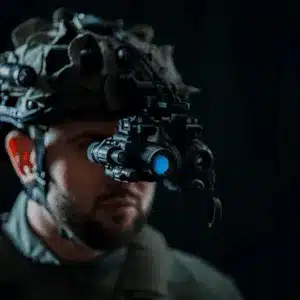
Traditional night vision goggles use image intensification to amplify ambient light. The process works through several steps that turn barely visible light into clear images.
Light collection starts when the objective lens gathers available light from around you. This includes visible wavelengths and some infrared light. Even starlight or moonlight that you cannot see gets collected by the optics.
The incoming light hits a photocathode, which converts photons into electrons. These electrons then move into a microchannel plate containing millions of microscopic channels. When electrons pass through, they hit the channel walls and release many more electrons in a cascading effect. A single photon gets multiplied thousands of times.
The multiplied electrons slam into a phosphor screen at the back of the tube. When electrons hit the phosphor, it glows and converts the electron image back into visible light. The result shows an intensified image much brighter than the original scene. Most military night vision goggles use green phosphor because human eyes see green detail very well.
You view the glowing phosphor image through eyepiece lenses. This creates the iconic green night vision image. The image intensifier tube takes scant available light and infrared from dark scenes and boosts them to create bright images. This gives you enhanced visibility in conditions ranging from low light environments to near total darkness.
This technology has built-in sensitivities. Exposing the intensifier to bright light can damage it. This makes maintenance and careful handling very important.
Digital night vision devices use sensors to capture low-light environment images and display them on screens. These often come as night vision binoculars with large screens. Digital units avoid damage from bright rays that analog tubes face. Thermal imaging devices detect heat rather than amplifying ambient light. They work well for finding warm objects in complete darkness or through smoke and fog.
Types of Night Vision Devices and Uses
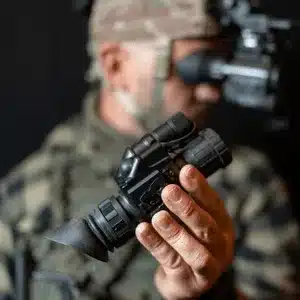
Night vision equipment comes in various forms. Understanding your type helps guide your maintenance approach and ensures optimal performance in all conditions.
A monocular provides vision to one eye and stays compact. Users often mount these on helmets or hold them by hand for wildlife observation or tactical use. Night vision binoculars or night vision goggles provide vision to both eyes. True night vision goggles typically have two image intensifier tube systems and two eyepieces for enhanced visibility. Head mounted night vision goggles or night vision binoculars attach to helmets or head harnesses and keep your hands free for wildlife observation, navigation, or cutting edge technology applications.
Such devices rely on the phosphor screen and image intensifier tube to amplify ambient light. Whether using head mounted systems or night vision goggles held in hand, proper care is vital. Regular cleaning of lenses and careful storage help maintain clarity and extend the life of the equipment.
From outdoor adventures to professional missions, knowing your specific type, whether night vision goggles, night vision binoculars, or head mounted gear, ensures you’re ready when visibility is poor. Relying on well-maintained night vision goggles provides the confidence needed for successful operations in dark environments.
Generational Technology: Gen 1 to Gen 3+
Night vision devices get classified by generation. Gen 1, 2, and 3 correspond to the technology in the image intensifier tube. Most professional and military users today rely on Gen 3 or newer tubes. Night vision goggles with Gen 3+ tubes offer better sensitivity, resolution, and features. Gen 3+ tubes often include automatic gated power supplies and automatic brightness control that rapidly adjust tube gain when brightness changes.
Modern night vision goggles often feature a microchannel plate within the image intensifier tube, enhancing clarity and ability to adapt. Head mounted night vision goggles and night vision binoculars are favored for wildlife observation, tactical operations, and hunting. Night vision goggles used with video recording deliver superior footage in darkness. Night vision binoculars mounted to head gear help operators wear systems comfortably during extended missions.
In the world of advanced optics, night vision goggles remain the gold standard. Their compatibility with video systems allows for real-time video capture, making them invaluable for documenting observations during wildlife observation or hunting trips. Always choose the right night vision goggles and head mounted setups for your specific needs.
Aviation Operations
Aviation professionals use night vision goggles for night flying operations. Helicopter pilots rely on them for medical evacuation, rescue operations, firefighting, and law enforcement aerial work. Military pilots and ground troops use them for navigation, target detection, and situational awareness during night missions.
Law Enforcement and Security Patrols

Law enforcement officers and security personnel use handheld or helmet-mounted night vision goggles for surveillance, looking for suspects, and security patrols in the dark. These devices improve ability to detect movement and objects at a distance and across a wide range.
Night vision goggles get classified by generation. Gen 1, 2, and 3 correspond to the technology in the image intensifier tube. Most professional and military users today rely on Gen 3 or newer tubes. These offer better sensitivity, resolution, and features. Gen 3+ tubes often include automatic gated power supplies and automatic brightness control that rapidly adjust tube gain when infrared brightness changes.
Night vision goggles equipped with infrared illuminators improve range in total darkness, ideal for hunting or tactical operations. The integration of video recording allows real-time surveillance and evidence capture. Operators can capture photo stills or stream video from their night vision goggles, enhancing situational awareness.
Video output paired with infrared capability supports detailed observation and analysis. Photo and video documentation prove valuable during hunting, surveillance, or security patrols. The extended range and advanced features of modern night vision goggles make them indispensable across various demanding applications.
Outdoor and Recreational Use
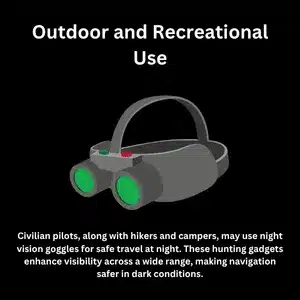
Civilian pilots, along with hikers and campers, may use night vision goggles for safe travel at night. These hunting gadgets enhance visibility across a wide range, making navigation safer in dark conditions. Night vision goggles equipped with infrared illuminators further improve clarity when darkness is present.
Hunters use night vision goggles and scopes for night hunting, allowing accurate target identification at extended range. Built-in infrared technology ensures precision and safety during these activities. Wildlife observers employ night vision goggles for wildlife observation in natural habitats after dusk, often recording video or capturing photos to document animal behavior.
Infrared capability also benefits surveillance operations. Security teams rely on night vision goggles and infrared-enhanced video feeds to monitor areas discreetly. Whether for recreation, safety, or professional use, night vision goggles with infrared technology prove invaluable tools after dark.
Each scenario demands reliable gear. A failure or blurry image at a critical moment can have serious consequences. Night vision devices tend to cost thousands of dollars and contain sensitive components. Over time, lenses can get dirty or misaligned. Batteries corrode and image intensifiers can degrade. A poorly maintained device might deliver poor image quality or fail completely when you need it most.
Best Practices for Maintaining Night Vision Goggles
Proper maintenance of infrared night vision goggles involves careful handling, regular cleaning, correct storage, and following manufacturer guidelines. These practices keep your night vision devices in top shape for low and dark conditions.
Protect from Bright Light

Always protect your night vision equipment from bright sources. Never turn on or use your night vision goggles in daylight or well-lit rooms without protective lens caps. Intense brightness can burn the sensitive image intensifier tube. Direct sunlight or high-intensity beams like car headlights, flashlights, or lasers can cause damage that cannot be fixed.
Many modern goggles have automatic cut-off circuits or auto-gating that provide some protection when exposed to brightness. These safeguards help but do not excuse careless use. Treat your device as a night-only instrument. Keep lens caps on in daylight. Most caps have tiny pinholes that allow safe training use in daylight by limiting light entry.
If you accidentally expose the goggles to a flash of light, turn them off right away. Preserving the dark-adapted state of the intensifier prolongs its life and maintains better image intensification performance.
Power Off When Not in Use
Get into the habit of turning off your night goggles when you are not actively using them. An intensifier tube left on idle can develop screen burn or phosphor burn, especially when pointed at the same scene for long periods. This might appear as blemishes or ghostly after-images on your display.
Even in low light conditions, leaving the device on unnecessarily ages the tube and drains the battery. Always switch off the device during pauses in operation and definitely before storing it away.
Handle with Care
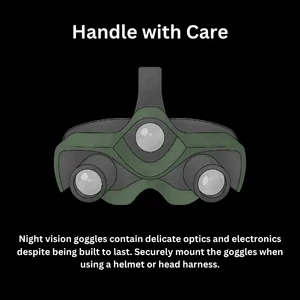
Night vision goggles contain delicate optics and electronics despite being built to last. Securely mount the goggles when using a helmet or head harness. Ensure the mount and straps stay tight and the device locks in place to prevent drops.
When handling the unit, hold it by the body. Avoid touching the lenses with your fingers. Natural skin oils, dirt, or grime can damage lens coatings or leave smudges that reduce image quality. Handle devices with clean hands and avoid unnecessary contact with optical surfaces.
Be mindful not to bang or crash the goggles into objects. A hard knock can misalign the optics and lead to problems like double vision in binocular units. Shock and vibration can also damage internal components, so avoid tossing your goggles around.
Keep Lenses and Optics Clean
The lens and eyepieces serve as your windows to the night. Dirty or scratched lenses can reduce clarity, create blurry spots, or cause light artifacts in the image. After each use, inspect the lenses for dust, smudges, or debris.
Use a blower or soft brush to remove loose dust before wiping. Rubbing debris on glass can scratch it. Use a microfiber cloth or lens tissue for wiping. Never use paper towels, facial tissue, or your shirt sleeve, as these can be rough on the glass.
If needed, apply a few drops of lens cleaning solution to the cloth, not directly on the lens. Gently wipe in a circular motion. Do not use strong solvents or glass cleaners not made for optics. These can strip protective coatings.
Clean both the objective front lens and eyepiece lenses. Also clean any glass surfaces on external infrared illuminators or optics for digital devices. Allow lenses to air-dry if you used any fluid before capping or storage.
Never take apart the lens elements on your own. If internal cleaning becomes necessary, take it to a professional service center. Regular cleaning ensures you get the best possible image quality from your device.
Remove Batteries When Storing
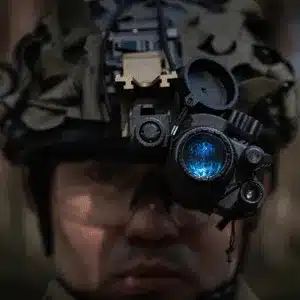
Almost all night vision goggles run on batteries. Common types include AA, CR123, or rechargeable packs. Never store the device with batteries inserted for long periods. Batteries can slowly lose charge and might leak corrosive chemicals over time. A leaky battery can destroy the device contacts or internal electronics.
After each night of use, power the device off and remove the batteries. Use the correct battery type as specified by the manufacturer for voltage and chemistry. Using an improper battery can damage the electronics or give poor performance.
Keep battery contacts clean. You can wipe the contacts in the battery compartment with a dry cotton swab to remove any residue. Store batteries in a cool, dry place to help them last longer. In the field, carry spares in a secure pouch.
Store in a Cool, Dry Place
Proper storage protects your night vision gear when not in use. Keep the goggles in a protective case, ideally the padded or hard case that came with the unit. This protects against dust, knocks, and sunlight. Choose a storage location that stays cool and dry.
Low humidity prevents problems since moisture harms electronics and optics. Excess humidity can cause internal fogging, mold on lenses, or corrosion on metal parts. If you live in a humid area, consider storing the device with desiccant packs in its case.
Avoid extreme heat or cold during storage. High heat can damage electronics and shorten the lifespan of image tubes. Never leave your night vision goggles in a hot car trunk or under direct sun. The black housing can absorb heat quickly and damage internal components.
Shield from brightness by keeping lens caps on or the device in a case. You do not want stray light slowly degrading the tube while stored.
Inspect and Test Before Use

Develop a routine of checking your night vision goggles before and after each use. Prior to a mission or outing, do a basic function check.
Start with a visual inspection. Look over the device housing for cracks, loose screws, or damaged wires. Ensure the objective lens, eyepieces, and any filters stay intact and clean. If you see any defects like cracks in lenses, significant scratches, or loose parts, address those before relying on the unit.
Do an operational check by turning the unit on in a dark room. Ensure it powers up properly and the image appears clear. Adjust the focus for both distance and your eye. You should get a sharp image at various distances, including at infinity focus for far objects.
Check all infrared light conditions settings. If it has gain control or brightness adjustment, test that. If the device has multiple modes like digital zoom features, cycle through to ensure they work.
Verify the battery stays fresh. Most goggles have a low-battery indicator. Make sure it does not flash at start.
Regular inspections help catch problems early. Some operational defects to watch for include shading, which appears as a dark shadow in the image. Edge glow shows as a bright ring on the edges. Bright spots that do not come from external brightness usually mean blemishes in the tube. Flickering or intermittent cut-outs could indicate loose connections or tube instability.
If you detect any serious issues, stop using the device and send it for professional evaluation and repair.
Follow the Manual and Manufacturer Guidelines
Every night vision device comes with a user manual that contains device-specific maintenance information. Read the manual for guidance on cleaning, acceptable operating temperatures, battery types, and troubleshooting. Following these instructions ensures you do not void warranties or damage the device by using improper methods or chemicals.
Time spent with the manual can save money and trouble by preventing mistakes that lead to expensive servicing.
Professional Maintenance and Calibration
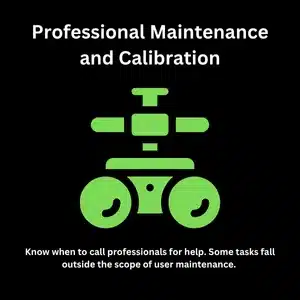
Know when to call professionals for help. Some tasks fall outside the scope of user maintenance. Image intensifier tubes have limited life and can sometimes need replacing after extensive use. Gen 3 tubes often last 10,000+ hours, but performance can degrade before complete failure.
Aligning a dual-tube device so both eyes see perfectly fused images requires delicate work typically done by technicians with specialized equipment. If you suspect a serious issue or if your device has taken severe shock or water damage, have it serviced.
Aviation users follow FAA guidance that requires certified repair stations to inspect and re-certify goggles every 180 days. These inspections examine every component from the battery pack and wiring to image quality under high and low light.
If you are a civilian user, consider sending your unit to the manufacturer or a reputable night vision service shop annually, especially if you use it heavily. This preventative maintenance can replace worn parts, update firmware on digital units, or upgrade components.
Do not attempt complex repairs yourself if you lack proper training. You could damage the device further. Instead, consult a professional technician for anything beyond basic care.
2025 Updates: Advanced Technology and Maintenance Considerations
Night vision technology continues developing rapidly. Modern advances as of 2025 bring more powerful, more durable, and easier-to-maintain goggles.
White Phosphor and Enhanced Tubes
More professionals now switch from classic phosphor tubes to white phosphor image intensifiers. White phosphor devices display black-and-white images with shades of gray that many users find provide better contrast and detail.
From a maintenance standpoint, white phosphor and green phosphor goggles need essentially the same care. Both use similar internal chemistry with just different phosphor coatings. Both remain vulnerable to bright light and rough handling. The cost of these tubes stays high, so protecting that investment becomes very important.
Manufacturers have also introduced filmless Gen 3 tubes which offer better low-light performance and faster auto-gating. These advances mean your goggles might handle low levels of light even better and recover from bright flashes faster. You should still treat bright light as harmful.
Ruggedized and Weatherproof Designs

The latest models often advertise improved durability. Examples include housings made of robust composites or metal, waterproof and fog-resistant sealing, and extended operating temperature ranges. Some goggles resist water or can be submerged to certain depths.
From a maintenance view, weatherproofing adds protection with less worry about rain or dust. However, waterproof does not mean you should deliberately soak or neglect drying the device if it gets wet. If your goggles have a water resistance rating, ensure battery compartments stay tightly closed.
After exposure to salt spray or mud, gently clean the exterior with a damp cloth and fully dry the unit. New rugged devices can take more abuse, but the goal of maintenance stays the same: avoid testing those limits unnecessarily.
Fusion and Digital Advances
Advanced gear now integrates night vision with thermal imaging and augmented reality overlays. Some systems combine an image intensifier with a thermal sensor for better target detection. Others add symbology by projecting maps or data into the night vision view.
These more complex systems might require software updates and have even more electronics to care for. If you have a digital or video-capable device, keep its firmware updated as recommended. Ensure ports like USB slots have their covers to keep dust out. Clean any display screens gently.
Improved Performance and Longevity
Across the industry, there is a push for tubes with higher signal-to-noise ratios, longer life, and better performance in extreme environments. New materials and designs enhance clarity and range. The cost of maintaining and updating devices is expected to drop as technology matures.
Modular designs allow easy part replacements and upgrades. This means that in coming years, you may be able to simply swap an old tube for a newer high-performance one or replace a scratched lens without buying a whole new unit. Some companies already offer trade-in or upgrade programs.
Night vision goggles in 2025 approaches major advances. Devices become more capable and somewhat easier to care for thanks to robust designs. However, basic maintenance principles remain unchanged. An excellent choice of device will only stay excellent if you treat it well.
Training and Professional Support

Because night vision devices represent sophisticated tools, proper training in their use and care proves invaluable. Many issues can be prevented or quickly fixed if the user has knowledge.
Professional training courses teach not only how to operate the devices under various conditions but also how to maintain and inspect them. Pilots learn pre-flight inspection routines and gain understanding of how devices interact with cockpit lighting. Law enforcement and military personnel often undergo training that covers field maintenance.
If you are a new user, consider seeking out training resources. Even many civilian shooting or hunting courses now include segments on night vision care. Hands-on training gives you confidence in handling the gear properly.
The 180-day inspection rule for aviation devices shows the importance of staying compliant with relevant standards. These standards base themselves on safety. Military units often have maintenance manuals which outline how and when to service devices.
If you ever feel a decline in your device performance that you cannot attribute to obvious causes like cleanliness or batteries, consult an expert. Companies that specialize in services for professionals can help. Do not hesitate to reach out to the manufacturer or authorized service centers.
For readers who use devices in aviation or want to deepen their expertise, consider formal training programs that include both operational and maintenance modules. Investing in education can greatly enhance your confidence in using the gear and addressing minor issues in the field.
Conclusion
Maintaining your infrared night vision goggles represents more than just routine care. It becomes an essential part of owning and operating these powerful tools. With careful attention, your night vision devices will deliver optimal performance when you need them. Whether you navigate a helicopter through a moonless night, conduct search and rescue in the wilderness, monitor a secure facility, or explore natural habitats after dark on nighttime adventures, proper maintenance ensures reliability.
Following best practices protects your gear from bright light, keeps it clean and dry, handles it gently, and inspects it regularly. This ensures that your equipment will function reliably in the darkest conditions for years to come.
The year 2025 finds us where night vision technology becomes more accessible and advanced than ever. Yet even the most advanced technology needs human attention to keep it at its best. Think of maintenance as part of the full package of night vision ownership, just as important as the device specifications themselves.
A well-maintained goggle not only gives you the ability to see in near total darkness, but it does so with clarity and consistency, night after night. This can save lives in professions like aviation, law enforcement, and military operations. It ensures enjoyable, frustration-free experiences for hobbyists and outdoor enthusiasts alike.
Treat your night vision gear with respect and it will reward you with excellent service. Clean the lenses so you get crystal-clear images. Check the power so it stays ready when you are. Shield it from harm so it can light up the night for you. The invisible world beyond the visible spectrum becomes visible through these devices. This represents an amazing feat, and good maintenance stays the price of admission for consistently harnessing that capability.
By implementing the expert insights and tips provided in this guide, you enhance your nighttime visibility and ensure your night vision goggles remain an excellent choice for seeing the unseen. Whether you work in the field on a critical mission or simply enjoy the experience of observing wildlife after dusk, you can move forward with confidence, knowing your equipment stays in peak condition.
In the end, a clear night vision image and a successful outcome will make all your maintenance efforts worthwhile. This applies whether you achieve a safe landing, apprehend a suspect, or create a treasured memory from a night time hike. Your investment in proper care pays dividends when darkness falls and you need to see what others cannot.

